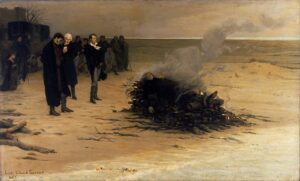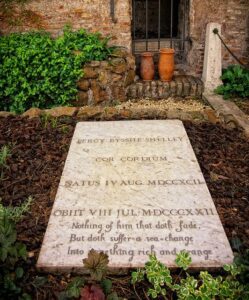
Portrait of Shelley by Alfred Clint (1819)
On this day in 1822, Romantic and lyric poet Percy Bysshe Shelley drowned in a sudden storm in the Golfo di Genova (Gulf of Genoa) while sailing back from Livorno, Italy to Lerici in his schooner, Don Juan, at the age of 29. Born on 4 August 1792 in Field Place, Horsham, England. Shelley, John Keats, and Lord Byron were the key figures in the second generation of the Romantic movement. Shelley married twice; Harriet Westbrook (1811-1816 her death) and Mary Wollstonecraft Godwin (who would go on to write the Gothic novel Frankenstein: or, The Modern Prometheus (1818)) (1816-1822 his death).
Perhaps best known for classic poems such as “Ozymandias”, “Ode to the West Wind”, “To a Skylark”, “Music, When Soft Voices Die”, “The Cloud” and The Masque of Anarchy. His other major works include a groundbreaking verse drama, The Cenci (1819), and long, visionary, philosophical poems such as Queen Mab (later reworked as The Daemon of the World), Alastor, The Revolt of Islam, Adonais, Prometheus Unbound (1820), Hellas: A Lyrical Drama (1821) and his final, unfinished work, The Triumph of Life (1822).
Shelley’s close circle of friends included some of the most important progressive/radical thinkers of his day, including his father-in-law, the philosopher William Godwin (1756–1836), and Leigh Hunt (1784–1859). Though Shelley’s poetry and prose output remained steady throughout his life, most publishers and journals declined to publish his work for fear of being arrested for either blasphemy or sedition. Shelley’s poetry sometimes had only an underground readership during his day, but his poetic achievements have become widely recognized today, and his political and social thought had an impact on the Chartist and other movements in England, and reach down to the present day. Shelley’s theories of economics and morality, for example, had a profound influence on Karl Marx (1818–1883); his early—perhaps first—writings on nonviolent resistance influenced Leo Tolstoy (1828–1910), whose writings on the subject in turn influenced Mahatma Gandhi, and through him Martin Luther King Jr. and others practicing nonviolence during the American civil rights movement.
Shelley became a lodestar to the subsequent three or four generations of poets, including Victorian and Pre-Raphaelite poets such as Robert Browning (1812–1889) and Dante Gabriel Rossetti (1828–1882). Admirers have included Oscar Wilde, Thomas Hardy, George Bernard Shaw, Leo Tolstoy, Bertrand Russell, W. B. Yeats, Upton Sinclair and Isadora Duncan. Henry David Thoreau’s Civil Disobedience (1849) apparently shows the influence of Shelley’s writings and theories on nonviolence in protest and political action. Shelley’s popularity and influence has continued to grow in contemporary poetry circles.
The Final Footprint
In keeping with quarantine regulations, Shelley was cremated on the beach where his body washed up, near Viareggio, Italy by Byron, and his friends Leigh Hunt and Edward Trelawny. In Shelley’s pocket was a small book of Keats’ poetry. The ashes of his heart are entombed in Saint Peter’s churchyard in Bournemouth, England. The remainder of his cremains are interred in Cimitero Acattolico, The Old Cemetery for Non Catholic Foreigners, Campo Cestio in Rome. His grave bears the Latin inscription, Cor Cordium (“Heart of Hearts”), and, in reference to his death at sea, a few lines of “Ariel’s Song” from Shakespeare’s The Tempest: “Nothing of him that doth fade / But doth suffer a sea-change / Into something rich and strange.” Shelley was memorialized later at Poets’ Corner in Westminster Abbey. Other notable final footprints at Cimitero Acattolico include; Gregory Corso, Keats and Trelawny (next to Shelley). Shelley’s cremation at Viareggio and the removal of his heart by Trelawny are described in Tennessee Williams’ play Camino Real by a fictionalized Lord Byron.

The Funeral of Shelley by Louis Édouard Fournier (1889). Pictured in the centre are, from left, Trelawny, Hunt, and Byron. In fact, Hunt did not observe the cremation, and Byron left early. Mary Shelley, who is pictured kneeling at left, did not attend the funeral.
 On this day in 1967, Academy Award-winning actress Vivien Leigh, Lady Olivier died from tuberculosis in London at the age of 53. Born Vivian Mary Hartley on 5 November 1913 in Darjeeling, Bengal, India. Her father was a British officer in the Indian Cavalry. One of film’s great dark haired beauties. Perhaps best known for her role as Scarlett O’Hara in the David O. Selznick and Victor Fleming film version of Margaret Mitchell’s Gone with the Wind (1939) with Clark Gable as Rhett Butler, Leslie Howard as Ashley Wilkes, Olivia de Havilland as Melanie Hamilton Wilkes, Hattie McDaniel as Mammy, Butterfly McQueen as Prissy, and Thomas Mitchell as Gerald O’Hara. My other favorite role performed by Leigh is Blanche DuBois in Elia Kazan’s film version of Tennessee Williams’s A Streetcar Named Desire (1951) with Marlon Brando as Stanley Kowalski. Leigh married twice; Herbert Leigh Holman (1932-1940 divorce) and Sir Laurence Olivier (1940-1960 divorce).
On this day in 1967, Academy Award-winning actress Vivien Leigh, Lady Olivier died from tuberculosis in London at the age of 53. Born Vivian Mary Hartley on 5 November 1913 in Darjeeling, Bengal, India. Her father was a British officer in the Indian Cavalry. One of film’s great dark haired beauties. Perhaps best known for her role as Scarlett O’Hara in the David O. Selznick and Victor Fleming film version of Margaret Mitchell’s Gone with the Wind (1939) with Clark Gable as Rhett Butler, Leslie Howard as Ashley Wilkes, Olivia de Havilland as Melanie Hamilton Wilkes, Hattie McDaniel as Mammy, Butterfly McQueen as Prissy, and Thomas Mitchell as Gerald O’Hara. My other favorite role performed by Leigh is Blanche DuBois in Elia Kazan’s film version of Tennessee Williams’s A Streetcar Named Desire (1951) with Marlon Brando as Stanley Kowalski. Leigh married twice; Herbert Leigh Holman (1932-1940 divorce) and Sir Laurence Olivier (1940-1960 divorce).
 The Final Footprint – Leigh was cremated at the Golders Green Crematorium in London and her cremains were scattered on the lake at her home, Tickerage Mill, near Blackboys, East Sussex, England. A memorial service was held at St Martin-in-the-Fields, with a final tribute read by actor John Gielgud. GGC was the first crematorium to be opened in London, and one of the oldest crematoria in Britain. The crematorium, the Philipson Family mausoleum, designed by Edwin Lutyens, the wall, along with memorials and gates, the Martin Smith Mausoleum, and Into The Silent Land statue are all Grade II listed buildings. The gardens are included in the National Register of Historic Parks and Gardens. GGC is in Hoop Lane, off Finchley Road, Golders Green, London NW11, ten minutes’ walk from Golders Green tube station. It is directly opposite the Golders Green Jewish Cemetery. The crematorium is secular, accepts all faiths and non-believers; clients may arrange their own type of service or remembrance event and choose whatever music they wish. Other notable cremations at GGC include; Kingsley Amis, Neville Chamberlain, T. S. Eliot, Sigmund Freud, Henry James, Rudyard Kipling, Keith Moon, Peter Sellers, Bram Stoker, H. G. Wells, and Amy Winehouse.
The Final Footprint – Leigh was cremated at the Golders Green Crematorium in London and her cremains were scattered on the lake at her home, Tickerage Mill, near Blackboys, East Sussex, England. A memorial service was held at St Martin-in-the-Fields, with a final tribute read by actor John Gielgud. GGC was the first crematorium to be opened in London, and one of the oldest crematoria in Britain. The crematorium, the Philipson Family mausoleum, designed by Edwin Lutyens, the wall, along with memorials and gates, the Martin Smith Mausoleum, and Into The Silent Land statue are all Grade II listed buildings. The gardens are included in the National Register of Historic Parks and Gardens. GGC is in Hoop Lane, off Finchley Road, Golders Green, London NW11, ten minutes’ walk from Golders Green tube station. It is directly opposite the Golders Green Jewish Cemetery. The crematorium is secular, accepts all faiths and non-believers; clients may arrange their own type of service or remembrance event and choose whatever music they wish. Other notable cremations at GGC include; Kingsley Amis, Neville Chamberlain, T. S. Eliot, Sigmund Freud, Henry James, Rudyard Kipling, Keith Moon, Peter Sellers, Bram Stoker, H. G. Wells, and Amy Winehouse.
#RIP #OTD in 1972, Chicago bandleader, session musician, composer, singer, arranger during the 1920s classic blues era, Lovie Austin died in Chicago, aged 84. Mount Glenwood Memory Gardens South, Glenwood, Illinois
RIP #OTD in 2012 US Navy veteran, actor (From Here to Eternity, Vera Cruz, Bad Day at Black Rock, The Wild Bunch, Marty) Ernest Borgnine died of kidney failure at Cedars-Sinai Medical Center in Los Angeles, aged 95. Cremation. Memorial bench Forest Lawn Cemetery, Hollywood HIlls
Have you planned yours yet?
Follow TFF on twitter @RIPTFF



Pingback: Come to Me in Dreams » TeaWithTater.com